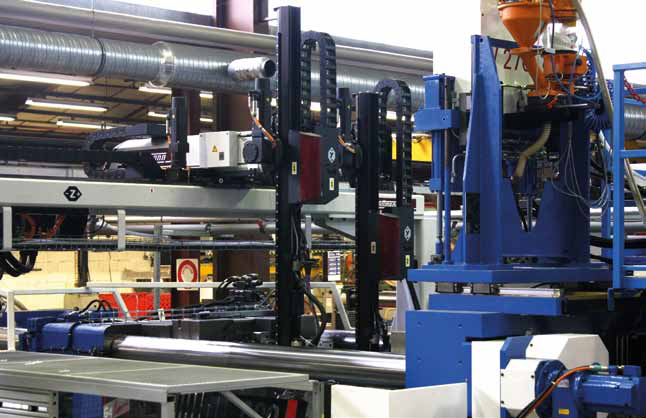A leading household goods manufacturer purchases tandem robot
Dominique Colbrant, Marketing and Sales Assistant of WITTMANN BATTENFELD France.
As the owner of such well-known brands as Seb, Calor, Tefal, Moulinex, Rowenta, Krups and Supor, the SEB Group is one of those top manufacturers of irons and steam generators that without which one cannot imagine the market.
The SEB Group has two facilities in France that are dedicated to the manufacture of irons and steam generators. One of these factories produces the required plastic parts and the other produces the metal parts and assembles the appliances.
Some six million individual parts are needed each year for these two commodities alone. Irons and steam generators are manufactured for the worldwide well-known SEB brands, Calor, Tefal, Moulinex and Rowenta. These are sold on the Asian and European markets, including Russia and Turkey. The SEB Group continues to enjoy strong growth. Turnover in 2013 was 4,161 million euros, which amounts to a doubling since 2000.
SEB Group products
The SEB Group's products must meet absolute strict requirements with regard to their ergonomics, especially those that are dictated by the risk inherent to operating one of these appliances. The safety and ergonomic specifications are very carefully formulated. The combination of heat, steam and electricity requires the implementation of specific technical features in order to comply with all the various standards.
The need for a watertight tank, for instance, is a feature that requires a specific method of production. Another less technical, more marketing-related consideration, concerns the customization of products with different color schemes and labeling (something that is demanded by the large retail chains). On top of this, of course, come reliability, functionality and design aspects. These are all important criteria that affect the choice of equipment used for manufacturing.
The plant in St. Jean de Bournay currently has 53 injection molding machines with a clamping force ranging from 22 to 800 tons that are capable of processing up to three different materials at the same time, plus around 45 linear and 16 six-axis robots. The machines produce housings for steam generators, water reservoirs for irons and various other parts (handles, caps etc.).
The numerous technical constraints require that the robots be integrated into a production environment that is very restricted in terms of space, with the primary objective of minimizing part removal time. (All of the above-mentioned aspects have a direct impact on the production cycle of the machine.)
In order to meet the growing demand, production operates in shifts, including over weekends, without the possibility of interruption.
An enduring partnership
A genuine relationship of trust has been built up with the WITTMANN BATTENFELD company over the years. One contributing aspect is the absolute confidence in WITTMANN BATTENFELD's sales department, which has time and again managed to come up with technical solutions that have fully met the needs of SEB and which has supported the on-site innovation process. Another factor that contributes to the smooth cooperation enjoyed is the excellent relationship between the technicians and engineers of each company.
These relationships have been further strengthened through a comprehensive training program that has provided both parties with an in-depth knowledge of one another's products.
The acquisition of a tandem robot
Always on the look-out for new solutions, the SEB Group recently invested in a WITTMANN tandem robot. The final step of the manufacturing process of a tank made from three different materials involves two parts being overmolded. The decision to buy a tandem robot was the result of lessons learned from previous experiences.
In the past, the SEB Group used a single robot. It performed the necessary functions, but required a picker arm that was not precise enough, and most importantly, caused a significant delay in the mold area. The use of two classic robots was precluded due to the restricted amount of space available.
The tandem robot turned out to be the best solution in terms of both robustness (W832) and space requirement (the compact design of a WITTMANN robot). It makes a special mode of operation possible whereby two robots are able to enter the mold area of the machine simultaneously (in this case, a 3-component rotary mold). This solution is also a world first for WITTMANN.
• When the mold is opened, the first robot removes the tank that was overmolded during the previous injection process and places it onto a control station (external to the machine) where it gets checked for leaks and where the component is finalized before being packed manually in the packaging unit.
• The second robot removes the upper component of the tank and places it onto the lower component (the two parts are then ready to be overmolded).
The fact that the two operations could be separated from each other made it possible to achieve the targeted cycle time. The redesigned process has resulted in a highly efficient use of materials together with a rejection rate approaching zero.
The results after a few months in operation endorse the decision to employ exactly this piece of equipment. These positive results ultimately led SEB to purchase a second tandem solution from WITTMANN, which has already gone into operation.










